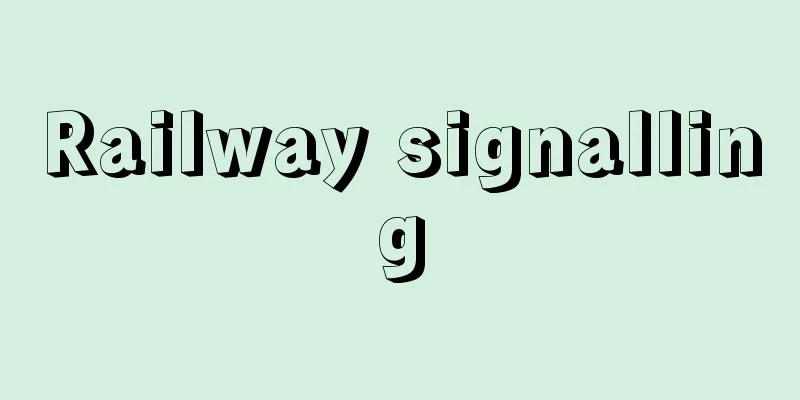Railway signalling

|
Signals are installed on railways to protect trains and vehicles and ensure the safety of operation by informing trains and vehicles of the conditions for their entry into certain sections of the railway tracks, such as speed, and to actively improve transportation efficiency. Railway signals are all designed to operate safely, such as by displaying stop signals to prevent dangerous accidents such as train collisions and derailments, even in the event of equipment failure. [Kitahara Fumio] Classification by useRailway signals are classified into signals, signals, and signs according to their purpose. Signals use color, light, shape, sound, etc. to indicate the conditions under which trains or vehicles should operate within a certain area, signals use color, light, shape, sound, etc. to convey the intentions of the signaler to the other party, and signs use color, light, shape, sound, etc. to indicate the status of equipment. Signals can be further divided into permanent signals, temporary signals, hand signals, and special signals. Permanent signals are signals that are permanently installed on the ground or inside the train, temporary signals are signals that are temporarily displayed at certain locations in the event of track failure, disasters, construction, etc., hand signals are signals that are displayed with lights or flags when signals are not installed or cannot be used, and special signals are signals that are displayed with lights, flames, or sounds when a train or vehicle is stopped in an emergency. [Kitahara Fumio] Permanent SignalDepending on where they are installed and their purpose, they are classified as (1) main signals, (2) subordinate signals, and (3) auxiliary signals. (1) Main signals Signals with a certain protection area include the following: [1] Home signals = Signals installed at the entrance to a station, which indicate whether trains may enter the station and which track they should enter. [2] Departure signals = Signals installed at the departure point of a station, which indicate to trains departing from the station whether the section ahead of the signal is open. Home and departure signals are used in combination with interlocking devices that are installed to ensure safe operation by comprehensively linking the direction of switch opening within the station and the positions of other trains and vehicles. [3] Block signals = Signals installed at the entrance to a block section installed in a certain area outside the station to allow only one train to operate, which indicate whether trains may enter the block section. Used in combination with a block device to ensure safe operation. [4] Guiding signal: A signal used when coupling trains, etc., located below the home signal, to guide a stopped train toward the inside of the home signal when a train or vehicle is in the protected area of the home signal and a stop signal is being displayed. [5] Shunting signal: When shunting vehicles within a station, this signal indicates whether or not it is permitted to enter the protected area. (2) Subordinate signals: These are subordinate to the main signal to compensate for the visibility and other recognition distance of the main signal, and include the following: [1] Distant signal: A signal subordinate to the home signal and located outside it, which gives advance notice of the signal aspect of the main home signal. [2] Passing signal: A signal subordinate to the departure signal and located outside it, which gives advance notice of whether or not it is permitted to pass through the station. [3] Intermediate signal = subordinate to home, departure and block signals, and installed outside the main signal. Installed to relay the main signal aspect when visibility from the main signal is poor. (3) Signal auxiliary devices Complement the conditions indicated by the main signal, and include the following: [1] Route indicator = An indicator installed below the main signal when a home, departure or shunting signal is shared for multiple routes, and shows the open route for that signal. [2] Route notice = Installed outside the home or departure signal when it is necessary to give notice of the open direction of the route, and installed below the signal outside the main signal. [Kitahara Fumio] Classification by structure[1] Color light traffic signal: A traffic signal is indicated by red, orange-yellow, or green light. There are two types: multi-light, which has a separate light source for each color, and single-light, which simply emits red, orange-yellow, or green light from a single light source. [2] Array traffic signal: A traffic signal uses two or more white lights, and indicates signals by lighting the lines connecting the lights horizontally, at a 45-degree angle, or vertically. It is mainly used for shunting signals and relay signals. [3] Semaphore traffic signal: A rectangular plate is attached to a pole as a semaphore, and during the day, signals are indicated by the position, color, and shape of the semaphore, and at night, signals are indicated by the color of the light passing through tinted glasses. [Kitahara Fumio] Classification by operation method[1] Manual signal: A signal that changes its signal aspect when operated by a signal operator. Those operated electrically are operated using an electric lever, while those operated mechanically using a wire or other means are operated using a mechanical lever. [2] Automatic signal: A signal that automatically changes the signal aspect using a track circuit (a device that detects the presence or absence of a train or vehicle by forming an electrical circuit using two rails and shorting it at the axle), eliminating the need for a signal operator. [3] Semi-automatic signal: Like automatic signals, a semi-automatic signal is automatically controlled by a track circuit, but can also be operated by a signal operator. Examples include yard and departure signals in automatic signal sections. [Kitahara Fumio] Signal display systemThere are two-phase two-aspect and three-aspect, and three-phase three-aspect, four-aspect, and five-aspect. In the two-phase system, two colors are used: horizontal and 45 degrees downward in the case of the arm system, and red and green or orange-yellow and green in the case of the color light system. In the three-phase system, three colors are used: red, orange-yellow, and green in the case of the color light system. Usually, each color is displayed alone (three aspects), but to improve driving efficiency, four-aspect or five-aspect systems are sometimes used, which include a warning signal using two orange-yellow lights and a deceleration signal using two orange-yellow and green lights. A warning signal indicates that it is OK to proceed beyond the signal at a speed of 25 kilometers per hour or less, a caution signal indicates that it is 45 kilometers per hour or less, and a deceleration signal indicates that it is 65 kilometers per hour or less. [Kitahara Fumio] Ground Signaling and In-Car SignalingThe general signaling system is a wayside signaling system where signaling mechanisms are installed near the tracks, but it is easily affected by weather conditions such as thick fog, and it becomes difficult for crew members to check the indications when operating at high speeds. For this reason, a cab signaling system was developed that transmits signal information directly to the car via the rails. This system is more expensive than wayside signaling, but in recent years, in order to improve safety, it has been actively adopted as a cab signaling system combined with an automatic train control system (ATC) that automatically controls the train speed, not only on the Shinkansen, but also on metropolitan trains and subways such as the Yamanote Line, Keihin Tohoku Line, and Saikyo Line. [Kitahara Fumio] "History of the Development of Railway Signals" (1970), edited and published by the Signal Safety Association [Reference] |©Shogakukan "> Railway signal classification ©Shogakukan "> Main types of railway signals Source: Shogakukan Encyclopedia Nipponica About Encyclopedia Nipponica Information | Legend |
|
鉄道において、列車、車両を防護し、運行の安全確保を図るために、鉄道線路の一定区域に、列車、車両などが進入することの是非、速度などの条件を知らせるとともに、さらに積極的に輸送能率の向上を目ざすために設けられる信号。鉄道信号は、設備の故障時においても、列車衝突、脱線などの危険側事故が発生しないよう停止信号を現示させるなど、すべて安全側に動作するように設計されている。 [北原文夫] 用途別分類鉄道信号は、用途に応じて、信号、合図、標識に分類される。信号は、色、光、形、音などによって、列車または車両に対し一定区域内を運転するときの条件を指示するもの、合図は、色、光、形、音などによって、合図者の意志を相手方に伝えるもの、標識は、色、光、形、音などによって、設備の状態を表示するものである。 信号をさらに細分すると、常置信号、臨時信号、手信号、特殊信号に分類される。常置信号は、地上または車内に常置して現示する信号であり、臨時信号は、線路の故障、災害や工事などのときに、当該箇所に臨時に現示する信号であり、手信号は、信号機の設備されていないとき、もしくは使用できない状態のときに、灯や旗によって現示する信号であり、特殊信号は、緊急に列車または車両を止める場合、発光機、火炎または音などで現示する信号である。 [北原文夫] 常置信号設置される場所、使途によって、(1)主信号機、(2)従属信号機、(3)信号付属機に分類される。(1)主信号機 一定の防護区域をもつ信号機で、次のようなものがある。〔1〕場内信号機=停車場の入口に設ける信号機で、停車場内に列車が進入してよいかどうか、また何番線に進入するかを指示する。〔2〕出発信号機=停車場の出発箇所に設ける信号機で、停車場を出発する列車に対して、その信号機の前方区間が開通しているかどうかを指示する。なお、場内および出発信号機は、停車場内の分岐器開通方向、他の列車や車両の位置などを総合的に関連づけて、安全運行を確保するために設けられる連動装置と組み合わされて用いられる。〔3〕閉塞(へいそく)信号機=停車場外の一定の区域に、一列車のみを運転させるために設けられた閉塞区間の入口に設ける信号機で、閉塞区間に列車が進入してよいかどうかを指示する。安全運行を確保するための閉塞装置と組み合わされて用いられる。〔4〕誘導信号機=列車を併結する場合などに用いる信号機で、場内信号機の下側に設け、場内信号機の防護区域に列車または車両があって停止信号を現示しているとき、いったん停止した列車を、場内信号機内方に誘導するために設けられる。〔5〕入換え信号機=停車場内で車両入れ換えをする場合、防護区間に進入してよいかどうかを指示する。(2)従属信号機 主体の信号機の見通しなどの認識距離を補うことを目的に主信号機に従属して設けられるもので、次のようなものがある。〔1〕遠方信号機=場内信号機に従属して、その外方で、主体の場内信号機の信号現示を予告する信号機。〔2〕通過信号機=出発信号機に従属していて、その外方に設けられる信号機で、停車場を通過してよいかどうかの予告指示をするために設けられる。〔3〕中継信号機=場内、出発信号機および閉塞信号機に従属していて、主体の信号機の外方に設けられる。主体の信号機の見通しが悪いときなどに、主体信号現示を中継するために設けられる。(3)信号付属機 主体の信号機の指示する条件を補うもので、次のようなものがある。〔1〕進路表示機=複数進路に対して、場内、出発、または入換え信号機を共用したときに、主体の信号機の下部に設けられる表示機で、その信号機の開通進路を示す。〔2〕進路予告機=場内または出発信号機の外方で、進路の開通方向を予告する必要のあるときに設けられるもので、主体の信号機の外方の信号機の下側に設けられる。 [北原文夫] 構造別分類〔1〕色灯式信号機=赤色、橙黄(とうこう)色、緑色の色灯によって信号を現示するもので、各色の光源を別々にもっている多灯形と、単に1個の光源から赤色、橙黄色、緑色の光を出す単灯形とがある。〔2〕灯列式信号機=白色灯を二灯以上用いて、各灯を結んだ線が水平、斜め45度、垂直になるように点灯して信号を現示する。主として入換え信号機、中継信号機などに用いられている。〔3〕腕木式信号機=腕木として長方形板を柱に取り付け、昼間は腕木の位置、色、形状などによって信号を現示し、夜間は着色した色眼鏡を通した灯光の色によって信号を現示する。 [北原文夫] 操作方法別分類〔1〕手動式信号機=信号扱い者が操作することにより、信号現示を出す信号機。電気で動作するものは電気てこなどにより、機械的にワイヤーなどで操作するものは機械てこで扱われる。〔2〕自動式信号機=軌道回路(2条のレールにより電気回路を構成し、車軸で短絡することによって、列車または車両の有無を検知する装置)を使用して自動的に信号の現示を変化させる信号機で、信号扱い者は不要となる。〔3〕半自動式信号機=自動式信号機と同様に、軌道回路によって自動的に信号機の現示を制御させるとともに、信号扱い者も操作することができる信号機。自動信号区間の場内、出発信号機などが該当する。 [北原文夫] 信号の現示方式信号現示方式には、二位式二現示・三現示、三位式三現示・四現示・五現示がある。二位式は、腕木式の場合は、水平と下向き45度、色灯式の場合は、赤色と緑色、または橙黄色と緑色の二色が使用される。三位式は、色灯式の場合、赤色、橙黄色、緑色の三色が使用される。通常は、各色の単独現示(三現示)が多いが、運転効率を高めるなどのために、橙黄色の二灯使用による警戒信号現示、橙黄色と緑色との二灯使用による減速信号を加えた四現示式、または五現示式が用いられることがある。警戒信号は時速25キロメートル以下、注意信号は時速45キロメートル以下、減速信号は時速65キロメートル以下の速度で、その信号機を越えて進行してよいことを示す。 [北原文夫] 地上信号方式と車内信号方式一般的な信号方式は、線路近傍に信号機構を建植(けんしょく)する地上信号方式であるが、濃霧などの気象条件に左右されやすく、高速運転に際しては乗務員による現示確認が困難となってくる。このため、レールを介するなどして車上へ信号情報を直接伝送する車内信号方式が開発された。本方式は、地上信号方式に比べると高価であるが、最近では、保安度向上のため、自動的に列車速度を制御する自動列車制御装置(ATC)と組み合わせた車内信号方式として、新幹線のほかにも、山手(やまのて)線、京浜東北線、埼京(さいきょう)線などの大都市圏電車、地下鉄などで積極的に採用されてきている。 [北原文夫] 『信号保安協会編・刊『鉄道信号発達史』(1970)』 [参照項目] |©Shogakukan"> 鉄道信号の分類 ©Shogakukan"> 鉄道信号のおもな種類 出典 小学館 日本大百科全書(ニッポニカ)日本大百科全書(ニッポニカ)について 情報 | 凡例 |
<<: Railway luggage - Tetsudo Motsu
>>: Railway Song - Tetsudoshouka
Recommend
Umoreougigani - Umoreougigani
This crab belongs to the order Decapoda, class Cr...
Taxi meter - takushi-me-ta (English spelling)
A measuring device that displays the fare for tax...
Mystical theology - Shinpishingaku (English spelling) theologia mystica
It is a branch of Christian practical theology, an...
LD-AC method - LD-AC method
...Most of the furnaces currently operating in Ja...
Tarbagan
…Also known as Tarbahan or Tarbagan. A rodent mam...
Antonio Salieri
Italian composer. Born in Legnago near Verona. He...
Acta senatus (English spelling)
...Today, many newspaper companies apply this spe...
Administrative regional magazine - Gyosei Chikishi
… On the other hand, geography explores the funct...
Water - Mizu (English spelling)
Pure water is colorless, tasteless, and odorless,...
Steroid
…The color of stool is due to bile pigments. Norm...
Microroids
...A group of venomous snakes of the Elapidae fam...
matrix cell
...Figure 1 shows the morphology of the human bra...
《Language》(Bloomfield) (English) Language
… [Bloomfield and Structural Linguistics] Meanwhi...
Nobel Prize - Nobel Prize
The prize is awarded annually by four institutions...
Asai Kozaemon - Asai Kozaemon
…(1) First Generation (1758-1824, 8th year of Hor...









